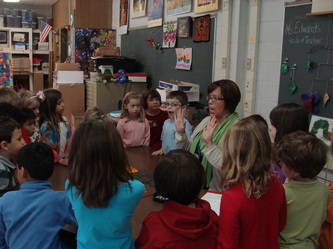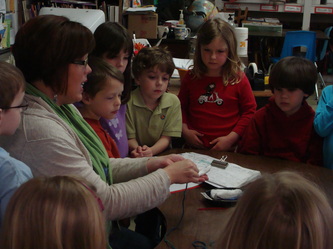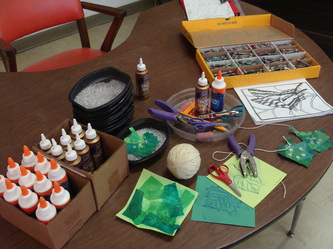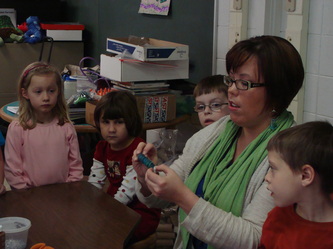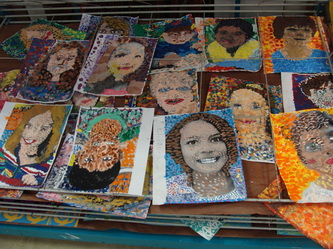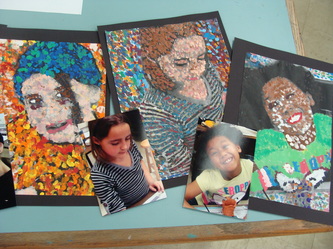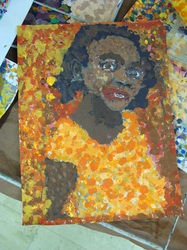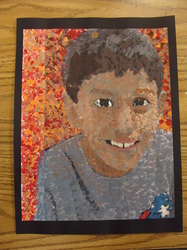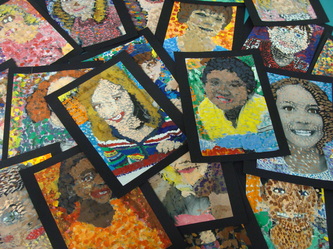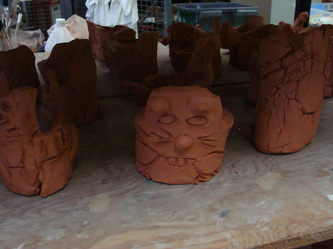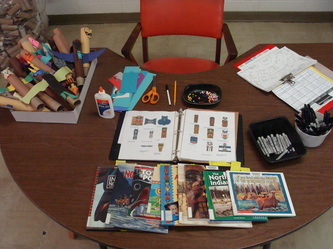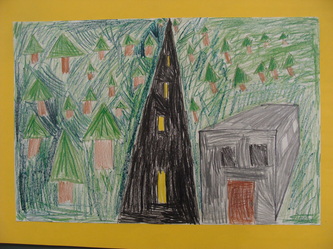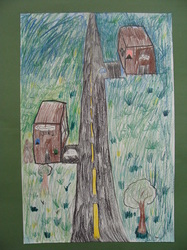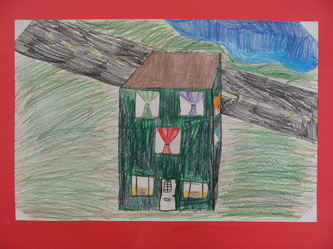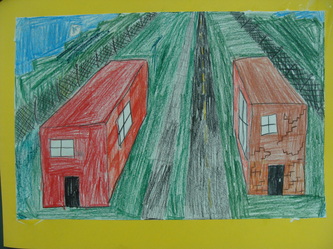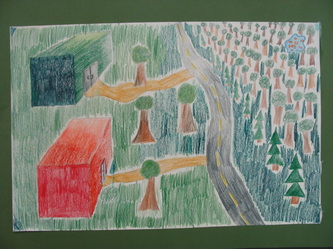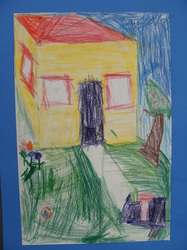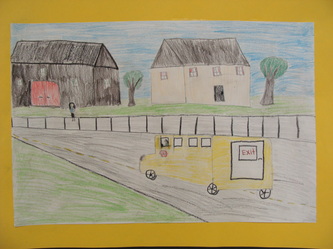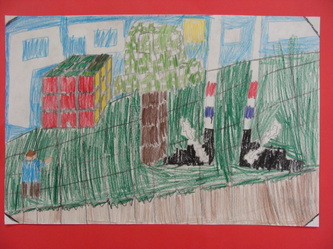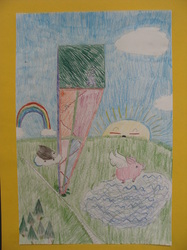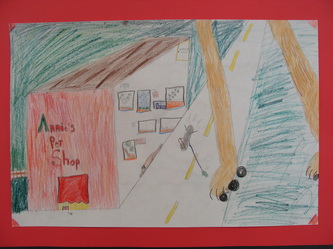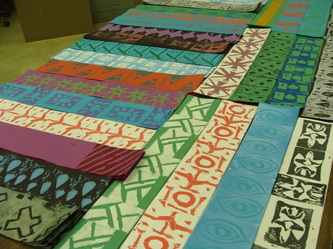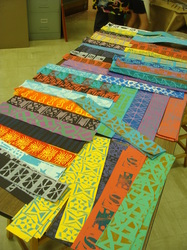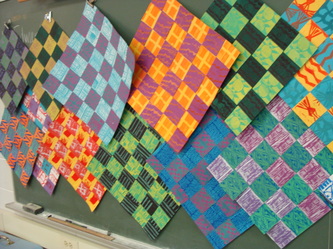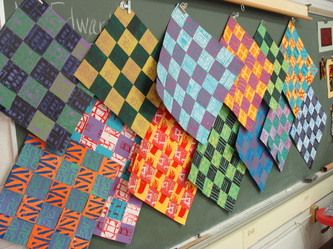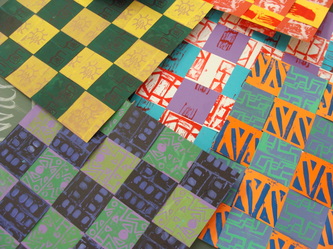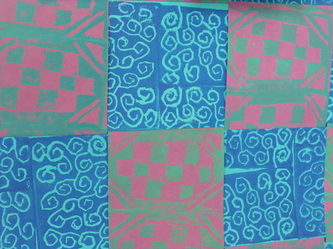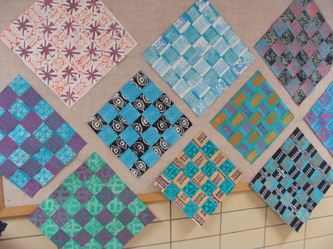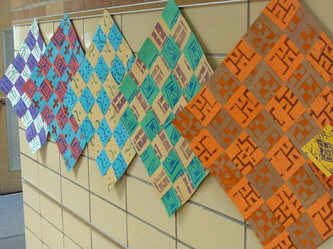k-5 sTUDENT gALLERY...
bUTTERFLY LIFECYCLE MOBILE: KINDERGARTEN

We began our unit with reviewing our field trip to the Franklin Park Conservatory: Blooms & Butterflies. We surveyed what was seen, activities, & what was learned. We also made a connection to their classroom because the students were given their own larva. During the next several weeks they would begin to see the metamorphosis of a larva/caterpillar to an adult butterfly. The next step was to introduce the art project and how it connects with their classroom curriculum; making a life cycle mobile of the butterfly that will reflect what the students will visually experience in the classroom. My unit introduced the importance of selecting materials that are both appropriate in color and weight. Each week the students created one stage of the life cycle and concluded with assembling all four stages into a mobile.
sELF-pORTRAIT pOINTILLISM: 1ST & 2ND gRADE

Students were introduced to a unit of Pointillism by identifying the different "STYLES" of artwork they have been exposed to. Students were asked to define what "style" meant. Example: Impressionism, Realism, Cubism. Again, the word "style" was defined by the way paint is applied to the surface of the paper or the canvas. Students were exposed to different styles of artwork: Renaissance, Impressionism, Realism, (ex.Van Gogh (short strokes and heavy paint), Picasso, Cezanne). Students recognized the similarities and differences based upon the different type of brushstrokes: smooth, blended, color, background). Students began recognizing several of George Seurat's artwork from popular prints they have seen before as well as artwork viewed during the Art's Off Campus field trip to the Columbus Museum of Art. A painting was compared in size to the windows in the art room and learned Seurat spent five years to complete the painting. Students developed an appreciation and patience for the time intensive activity. Students understood that blending of colors did not occur with brushstrokes but as an optical illusion; tricking the eye by the eye blending the dots of color together. Students also learned how to darken colors without using black paint because Pointillist did not use black.
tOTEM pOLES: 1ST & 2ND GRADE

The unit was presented to the students following a project of the Plains Indians. The students viewed a PowerPoint Presentation of the Northwest Indians. During the presentation the class discussed the similarities and differences of the Plains Indians vs. the Northwest Indians. Students reviewed animal symbolism packets and began sketching and creating their own stories. Students watched a demonstration of building clay bases for their totem poles and creative techniques to approach the design aesthetic similar to the Northwest Indian totem poles. Students created their own clay bases. Bases were made from terracotta clay. Students drew final sketches on colored construction paper and begin layering paper and using techniques to create animals to be dimensional on the totem poles. Students observed several techniques to make all four sides of totem poles interesting. Each week the students reviewed techniques to create simple shapes, patterns, and designs similar to the Northwest Indian totem poles. Each week students were introduced to new ideas and techniques to build upon the previous weeks knowledge.
ONE POINT PERSPECTIVE: 3RD & 4TH gRADE
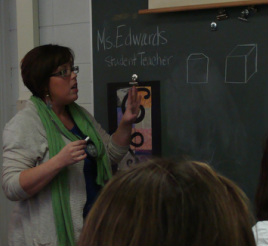
Students were provided a handout to review shapes and to identify what makes a shape 3 dimensional. I demonstrated exampled on chalk board: cube, cone, etc., and students followed along and practiced examples of their own. Students were then introduced to a transition lesson into perspective drawing. "Over, Under, & Through Project". I provided multiple examples to approach project. The purpose of the transition lesson was to have the students begin thinking about space surrounding objects and creating volume. Students sketched in either sketchbooks or newsprint to practice composition. Once the project was complete students further developed their understanding of form in space through perspective drawing. My introduction included: vocabulary, artist's samples (teacher, students, historical). Students viewed a power point presentation of multiple artists throughout history that have used perspective drawing in their own artwork. Examples: Leonardo da Vinci, Raphael, Jan Vermeer, Andrew Wyeth, M.C. Eischer, Richard Hamilton, Chen Jiao. Students created own perspective drawing based upon the information they learned and were most influenced. To conclude the project, in additional to having a supplemental activity, students could make a time-line and/or map of the influence perspective drawing had throughout history. Students developed problem solving skills and a greater appreciation and value of how artists have used the skill of perspective drawing throughout history.
kENTE CLOTH TEXTILE PROJECT: 5TH GRADE
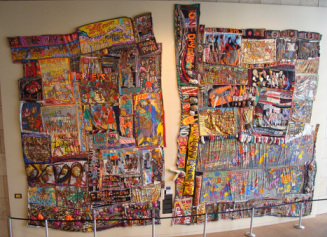
My unit was based on the understanding how African Art has influenced African American Art. We began our unit with learning about the Kente Cloth, the origins, and the symbolism. The next step in the unit was having the students make their own Kente cloths from hand-printing linoleum reduction blocks on 3 inch strips of paper and finalizing the project by weaving the paper together into a cloth-like pattern. Students had the opportunity to make connections between their field trip to Cincinnati's Freedom Center and the curriculum in the classroom. The students also had the privilege to view Aminah Robinson's artwork and how she as an African American artist continues to be influenced by the traditional African textiles.



